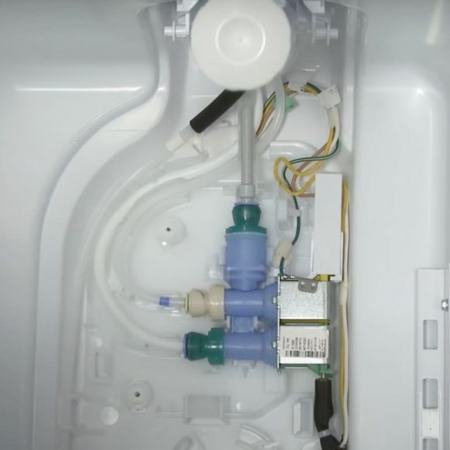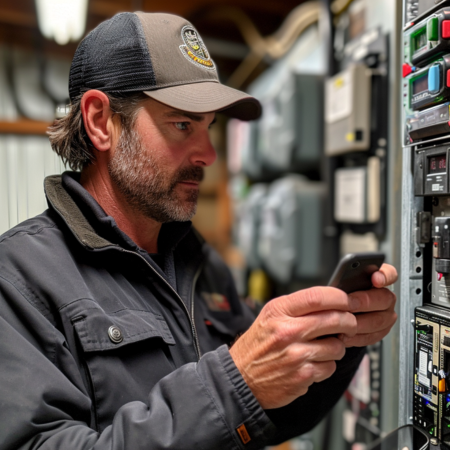If you own a Samsung refrigerator, you must appreciate the convenience of having an ice maker on a hot day.
However, like any other appliance, it might not always operate as expected.
There can be various reasons why is Samsung ice maker not working, ranging from simple fixes like ensuring the ice maker is turned on to more complex issues relating to component failure.
This article will guide you through several common problems affecting your ice maker and their potential solutions.
Armed with this knowledge, you can troubleshoot and perhaps fix the problem yourself or make an informed decision when calling in a professional.
Key Points
- Power Connection: The first step in troubleshooting a malfunctioning ice maker is to ensure that the refrigerator is securely connected to a power source.
- Ice Maker’s Switch: Verify if the ice maker’s switch is turned on. Occasionally, it might be accidentally turned off.
- Water Supply: A disrupted or restricted water supply can prevent the ice maker from producing ice. It is essential to check the water supply line for blockages.
- Component Failure: The ice maker may stop functioning if certain internal components, such as the water inlet valve or the ice maker assembly, are defective or damaged.
Why Is Samsung Ice Maker Not Working
One of the most common issues leading to the malfunction of a Samsung ice maker can be as simple as a frozen line.
Other times, it could be a more intricate issue like an electrical fault in the ice maker.
Understanding these issues is key to efficient troubleshooting.
Keep reading to understand better five common problems that could cause your Samsung ice maker to stop working and how you can resolve them without needing a professional.
1. Look for Ice Blockage
A frequent problem with Samsung ice makers is ice blockage.
This occurs when ice clumps, preventing new ice from falling into the ice bucket.
The cause is often infrequent ice maker use, allowing ice to melt and refreeze into clumps.
To resolve this, you can manually break up the clumps or empty the ice bucket and let it refill with fresh ice.
If the issue persists, it may be due to a faulty defrost system causing excessive frost build-up.
In this case, a professional might be needed to repair or replace the defrost system.
Regular use and cleaning can prevent ice blockage and help your ice maker function efficiently.
2. Defective Water Inlet Valve
The water inlet valve is a crucial component that controls water flow into the ice maker.
If it malfunctions, the ice maker may not receive the necessary amount of water, leading to small or non-existent ice cubes.
This can be due to a faulty valve or issues with too low water pressure.
A simple way to check this issue is to inspect the valve for any signs of damage or leakage.

Check the water pressure if the valve appears in good condition.
If the water pressure is low, you may need to adjust your home’s pressure.
However, if the water inlet valve is faulty, it will need replacement.
Remember that replacing the water inlet valve on your ice maker may require specialized tools and knowledge.
In such a case, calling a professional might be the best action.
Regular maintenance and inspection can help catch such issues early and keep your ice maker in top condition.
3. Poor Water Pressure
Poor water pressure can drastically affect your ice maker’s performance. It can lead to smaller than usual ice cubes or, in some cases, no ice production.
If your water pressure is lower than recommended – generally below 20 psi for most models – it might not be sufficient to allow the water inlet valve to function properly.
You can test your home’s water pressure using a water pressure test gauge.
If the water pressure is low, you might need to adjust it.
Water pressure can be increased by adjusting the regulator, a bell-shaped device typically located where the water line enters the home.
Remember that your home’s water pressure adjustments should be done carefully.
In cases where water pressure is not the issue, but the problem persists, it might be a good idea to call in a professional to diagnose and fix the problem.
Regular check-ups and maintenance can help prevent such issues and keep your ice maker functioning.
4. Expired Water Filter
An expired water filter in your ice maker can significantly affect its performance. Over time, the filter accumulates impurities, reducing its effectiveness.
To maintain optimal performance, it’s crucial to replace the filter regularly. The general recommendation is every six months, but this can vary depending on your usage and water quality.
Ignoring this crucial maintenance step can lead to unpleasant odors or flavors in your ice. Worse, it could put undue strain on your ice maker, leading to potential mechanical issues.
A simple indicator that your filter may need replacement is a noticeable decrease in your ice maker’s production rate. It might be time to check your filter if you’ve ruled out other issues, such as water pressure or a faulty water inlet valve.
5. Failed Auger Motor
The auger motor plays a pivotal role in your ice maker’s operation. It’s a small motor that turns the drill, the spiral-shaped component that moves ice from the bin to the dispenser chute.
If the auger motor fails, it cannot effectively move the ice, leading to a reduced output or no ice.
Symptoms of an ailing auger motor include strange noises during operation or a complete failure of ice dispensing.
This issue can be diagnosed using a multimeter to test the motor for continuity.
If the auger motor has failed, it will need to be replaced.
This task should be assigned to a professional unless you’re comfortable dealing with electrical parts.
Remember, safety always comes first.
Attempting to repair the auger motor without proper knowledge can result in injury or further damage to your ice maker.
To prolong the life of your auger motor, be sure to perform regular maintenance and avoid overloading your ice maker.
How To Fix Samsung Ice Maker Not Working?
If your Samsung ice maker isn’t working, don’t panic.
Before calling a professional, there are several simple fixes you can try.
Whether it’s a clogged filter or a faulty auger motor, we’re here to guide you through troubleshooting to get your ice maker up and running again.
- Check that the water lines are not cross-connected (RS27T and RS22T models only):
For the RS27T and RS22T Samsung models, a common issue that may cause your ice maker to stop working is cross-connected water lines.
This issue happens when the water lines to the fridge and the ice maker get switched during installation or maintenance.

Locate your water lines and ensure they are connected to the proper outlets.
The water line that provides water for cooling should be connected to the ‘Cold Water In’ port.
The line that supplies water to the ice maker should be connected to the ‘Ice Maker In’ port.
If they’re cross-connected, switch them back.
Always shut off your water supply before handling water lines to prevent leaks or water damage.
- Resolve your water pressure issues before continuing:
Another common cause of ice maker malfunction is a clogged or old water filter.
It’s recommended to replace your Samsung refrigerator’s water filter every six months to ensure the best quality of water and ice.
If it has been over six months since you last replaced the filter, try replacing it with a new one and see if that solves the problem.
- Ensure the ice maker is turned on:
Sometimes, the solution could be as simple as turning on your ice maker.
Your Samsung refrigerator has an ‘Ice Off’ option that can accidentally be activated, halting the ice-making process.
To check, look at the control panel of your refrigerator. If the ‘Ice Off’ light is illuminated, press the button to deactivate it and restart the ice-making process.
It’s important to note that after turning the ice maker back on, you should allow some time to start producing ice again.
- Check the water pressure:
Low water pressure can also affect ice production in your Samsung refrigerator.
Ensure the water pressure is set to a minimum of 20 psi for optimal performance.
You can check the water pressure using a gauge on the cold water line.
- Reset the ice maker:
If none of the above solutions work, you may need to reset your ice maker.
This can often fix malfunctions and get it back up and running properly.
The process for resetting your Samsung refrigerator’s ice maker may vary depending on the model.
But it involves holding down a specific button or combination of buttons for a few seconds.
- Allow 8 hours for ice production to get back to normal:
After following these tips, it’s important to give your ice maker some time to return to its normal production.
It can take up to 8 hours for the ice maker to start producing a full batch of ice again, so be patient and check back periodically.
Conclusion
If you have followed all the above steps and your Samsung refrigerator is still not producing ice, it might be time to call a professional.
Technical issues beyond basic troubleshooting may require the expertise of a service technician.
Remember, untrained attempts at fixing deeper issues can lead to more damage or void your refrigerator’s warranty.
Therefore, if the problem persists, do not hesitate to contact a professional.
- Can You Put Microwave Popcorn In The Oven: Pros And Cons - May 14, 2024
- Can You Scrap A Microwave And Why You Should? - May 13, 2024
- Can You Put Metal In A Convection Microwave: 10 Major Risks - May 12, 2024

